Gillig Transit Coach School Bus
| Gillig Transit Coach | |
|---|---|
 | |
| Overview | |
| Manufacturer |
Gillig Brothers (1940–1969) Gillig Corporation (1969–1982) |
| Production | 1940–1982 |
| Assembly | Hayward, California |
| Body and chassis | |
| Class | Type D (transit-style) |
| Body style | School Bus |
| Layout |
Body-on-frame
|
| Platform | Gillig |
| Powertrain | |
| Engine |
Gasoline
Diesel
|
| Capacity | 60-97 passengers |
| Transmission |
|
| Dimensions | |
| Length | 28–40 feet (8.5–12.2 m) |
| Width | 96 inches (2.4 m) |
| Chronology | |
| Successor | Gillig Phantom School Bus |
The Gillig Transit Coach School Bus was a long-running series of transit-style (rear-engined and mid-engined) school buses produced by the Gillig Corporation in Hayward, California. Introduced in 1940, the Transit Coach was produced until 1982. It was replaced in 1986 by the school bus version of the Gillig Phantom.
Along with its chief competitor, the Crown Supercoach, the Transit Coach was marketed primarily to customers on or near the West Coast in California, Oregon, or Washington State. It was also one of the first school buses powered by a diesel engine.
Design history
1940–1957
In 1937, Gillig Brothers moved from San Francisco to Hayward, California. During this time, transit-style school buses were starting to be developed by a number of manufacturers. As opposed to a conventional-style body mounted on a truck frame, a transit-style bus allowed for greater seating capacity within the same bus length. Additionally, the engine could be mounted in a variety of locations. In 1940, after several years of experimenting, Gillig introduced a production transit-style bus. The bus showcased a design feature unusual for the time: a mid-mounted engine. The Hall-Scott gasoline engine was mounted under the floor on a Fabco chassis bodied by Gillig.[4] During World War II, Gillig bus production was put on hold.
In the post-war years, Gillig resumed production of Transit Coaches alongside conventional-body school buses. A rear-engined version was introduced in 1948, but was not as successful as the mid-engine version.[4] In either configuration, most Gilligs were powered by Hall-Scott engines. Through most of the 1950s, the Transit Coach design had only minor changes.
1957–1977
In 1957, Gillig Brothers purchased the product rights of the Pacific bus product line from Kenworth. The purchase would lead to major design changes for the Transit Coach that would be retained for many years. Alongside Gillig adapting some of Kenworth's body designs, the following changes were made in 1958–1959:[4]
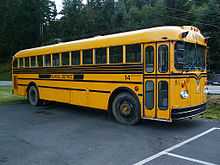
- Driver's windshield enlarged from 78"x30" to 86"x30" (the largest in the industry)
- On rear-engine models, the Kenworth's left-side roof-mounted high volume air intake was added.
The primary reason the Kenworth roof air intake was added was because Gillig was adding a new engine to the rear-engine Transit Coach. In 1959, the Model C-180 was introduced, named for its Cummins C-180 diesel engine.[4] The C-180 was the first rear-engine diesel-powered school bus; at the time, the few diesel-powered transit school buses were either mid-engined or front-engined. Although Gillig also introduced a mid-engined diesel in 1959 (the Model 743, with the Cummins NHH), the rear-engine models proved more popular, as they were not offered by chief competitor Crown Coach. In addition, manufacturers of rear-engine transits from the Eastern United States did not offer diesel power until the 1970s.
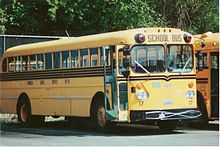
In the mid-to-late 1960s, school districts on the West Coast (along with the rest of the country) were faced with rising student populations as the bulk of the Baby Boom generation had reached school age. School buses were forced to grow in size to accommodate the extra students. In 1967, Gillig responded to the situation by introducing the largest school bus ever mass-produced. The Model 743DT-16 was introduced with a seating capacity of 97 student passengers.[4] Like similar models from Crown, the DT-16 featured tandem rear axles; unlike motorcoaches, both rear axles were live. Another change made that year was the standardization of the high-headroom roof option; instead of 72" (6'0") being standard, 79" (6'7") headroom was now standard inside all Gilligs. In 1974, the design of the dashboard was changed. To improve driver ergonomics, all switches were centralized onto a control panel to the left of the driver; many school buses use this layout today. 1974 was also the last year a gasoline-powered Transit Coach was produced.[4]
1977–1982
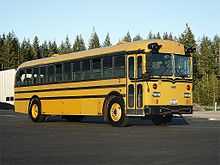
In April 1977, new federal safety standards went into effect that changed how school buses are constructed. Bodies had to be designed stronger to better survive crashes and rollovers, seats had to be redesigned, and other changes were made as well. Gillig's largest bus was now 90-passenger capacity, as the high back padded seats took up the extra space needed for the 16th row of seats. In states outside of California where Gilligs were sold, states began requiring amber warning lights along with the red lights seen since the 1940s.
During the 1979 model year, Gillig began to make the first visible changes to the exterior of the Transit Coach since the 1957 Kenworth purchase. Most noticeable was the change from drop-sash to split-sash windows used on school buses from the East Coast. To make room for the larger windows, the four thin guardrails below the window line, in place since the 1940s, disappeared in place of a single guard rail.
Discontinuation
For the school bus industry as a whole, the early 1980s was a period of struggle. At the same time Gillig had facelifted the Transit Coach, two East Coast manufacturers (Superior and Ward) had closed their doors; several others were also struggling financially. A key factor was that the Baby Boom generation that had fueled school bus sales 15 years earlier was now past school age. Gillig Corporation, as a fairly small-market manufacturer, saw its school bus sales drop off significantly. In the late 1970s, the company had diversified into the more profitable mass-transit market; in 1982, the Gillig Phantom was launched. Gillig Corporation made the decision to concentrate on mass-transit production, so the last Transit Coach and the last conventional-body school bus (whose production had dropped off much further) were produced in 1982. After a four-year hiatus, Gillig developed a successor to the Transit Coach school bus; the Gillig Phantom school bus was launched in 1986. The Phantom school bus struggled, as it proved to be far more expensive than alternatives from manufacturers from the East Coast. The last school bus version of the Phantom was produced in 1993.
Gillig Transit Coaches were frequently found in school bus fleets throughout the western United States, and some still remain in use today.
Production
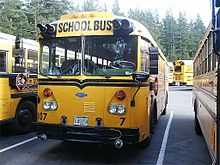
Gillig used the following numbering system to designate school bus models[5]
Body configuration
C-Type C (conventional) D-Type D (Transit Coach) T-Tandem rear axle
"#"-Number of rows of seats (maximum 16 before 4/1/1977, 15 after 4/1/1977)
Example: 426DT15= A Transit Coach with 15 rows of seats, tandem rear axles, and a 6N71 Detroit Diesel engine.
Depending on engine type, Transit Coaches were sold in 28'(only with gasoline engines), 30', 35', 37', and 40' body lengths. The two longest body lengths only were sold with a diesel engine (the 37' could not be ordered as a 318D, a C-Series, or a VTF555-D).
Engines
Diesel
- 636 – Caterpillar 1160/3208 V8 diesel
- C-160/170/180/190 – Cummins C-160/170/180/190 inline-six diesel
- VTF-555 – Cummins VTF555 V8 diesel
- 743 – Cummins NHH220/262 inline-six diesel
- 855 – Cummins NHH250/270/290/335 inline-six diesel
- 318 – Detroit Diesel 6V53 V6 diesel
- 426 – Detroit Diesel 6N71 inline-six diesel
Gasoline
- 534 – Ford Super Duty V8 (gasoline)
- 590 – Hall-Scott 590 cubic-inch 6-cylinder (gasoline)
- 501 – International RD-501 inline six (gasoline)
| Timeline of Gillig Transit Coach Production (1950–1985) | |||||||||||||||||||||||||||||||||||||||||||||||||||||||||||||||||||||||||||||||||||
| Bus Type | 1950s | 1960s | 1970s | 1980s | |||||||||||||||||||||||||||||||||||||||||||||||||||||||||||||||||||||||||||||||
| '50 | '51 | '52 | '53 | '54 | '55 | '56 | '57 | '58 | '59 | '60 | '61 | '62 | '63 | '64 | '65 | '66 | '67 | '68 | '69 | '70 | '71 | '72 | '73 | '74 | '75 | '76 | '77 | '78 | '79 | '80 | '81 | '82 | |||||||||||||||||||||||||||||||||||||||||||||||||||
| Gasoline Engine | 501 | ||||||||||||||||||||||||||||||||||||||||||||||||||||||||||||||||||||||||||||||||||
| 590D | |||||||||||||||||||||||||||||||||||||||||||||||||||||||||||||||||||||||||||||||||||
| 534D | |||||||||||||||||||||||||||||||||||||||||||||||||||||||||||||||||||||||||||||||||||
| Caterpillar Diesel Engine | 636D | ||||||||||||||||||||||||||||||||||||||||||||||||||||||||||||||||||||||||||||||||||
| Cummins Diesel Engines | C-160D | ||||||||||||||||||||||||||||||||||||||||||||||||||||||||||||||||||||||||||||||||||
| C-180D | |||||||||||||||||||||||||||||||||||||||||||||||||||||||||||||||||||||||||||||||||||
| C-190D | |||||||||||||||||||||||||||||||||||||||||||||||||||||||||||||||||||||||||||||||||||
| 743D/DT | 855D/DT | ||||||||||||||||||||||||||||||||||||||||||||||||||||||||||||||||||||||||||||||||||
| VTF555D/DT | |||||||||||||||||||||||||||||||||||||||||||||||||||||||||||||||||||||||||||||||||||
| Detroit Diesel Engines | 318D | ||||||||||||||||||||||||||||||||||||||||||||||||||||||||||||||||||||||||||||||||||
| 426D/DT | |||||||||||||||||||||||||||||||||||||||||||||||||||||||||||||||||||||||||||||||||||
Comparable products

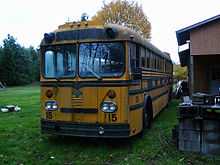
Regional
- Crown Coach Corporation
- Crown Supercoach
- Kenworth
- Kenworth-Pacific T-126
National
- Blue Bird Body Company/Blue Bird Corporation
- Carpenter Body Works
- Carpenter Corsair
- Perley A. Thomas Car Works/Thomas Built Buses, Inc.
- Superior Coach
- Superior SuperCruiser
- Ward Body Works
- Ward President
- Wayne Corporation
- Wayne Rear Engine
See also
- Crown Coach Corporation – former competing school bus manufacturer
- Kenworth – former competing school bus manufacturer (Kenworth sold the school bus division to Gillig, and began focusing solely on semi trucks)
References
- Gillig Corporation, gillig.com, retrieved on 2008-01-22
- Gillig Transit Coach / Pacific SchoolCoach Online Museum, gilligcoaches.net, retrieved on 2008-01-22
- Leo Gillig Automobile Works – Gillig Brothers, coachbuilt.com, retrieved on 2006-12-25
- A Brief History of Hall-Scott, northern.edu, retrieved on 2006-12-26
Notes
- ↑ http://web.archive.org/web/20090920071125/http://www.gilligcoaches.net/downloads/pdf/Gillig_Coach_672D_13_specifications.pdf
- ↑ http://web.archive.org/web/20090920071101/http://www.gilligcoaches.net/downloads/pdf/1977GilligTransitCoach_Build_Your_Own_Bus.pdf
- ↑ http://web.archive.org/web/20090920071101/http://www.gilligcoaches.net/downloads/pdf/1977GilligTransitCoach_Build_Your_Own_Bus.pdf
- ↑ 4.0 4.1 4.2 4.3 4.4 4.5 The Gillig Story... Then and Now,gillig.com, retrieved on 2008-01-21
- ↑ http://www.gilligcoaches.net/pages/gillig_trivia.html: Information on Gillig Model Numbers
External links
| ||||||||||||||||||||||||
| ||||||||||||||||||||||||||||||||||||||||||